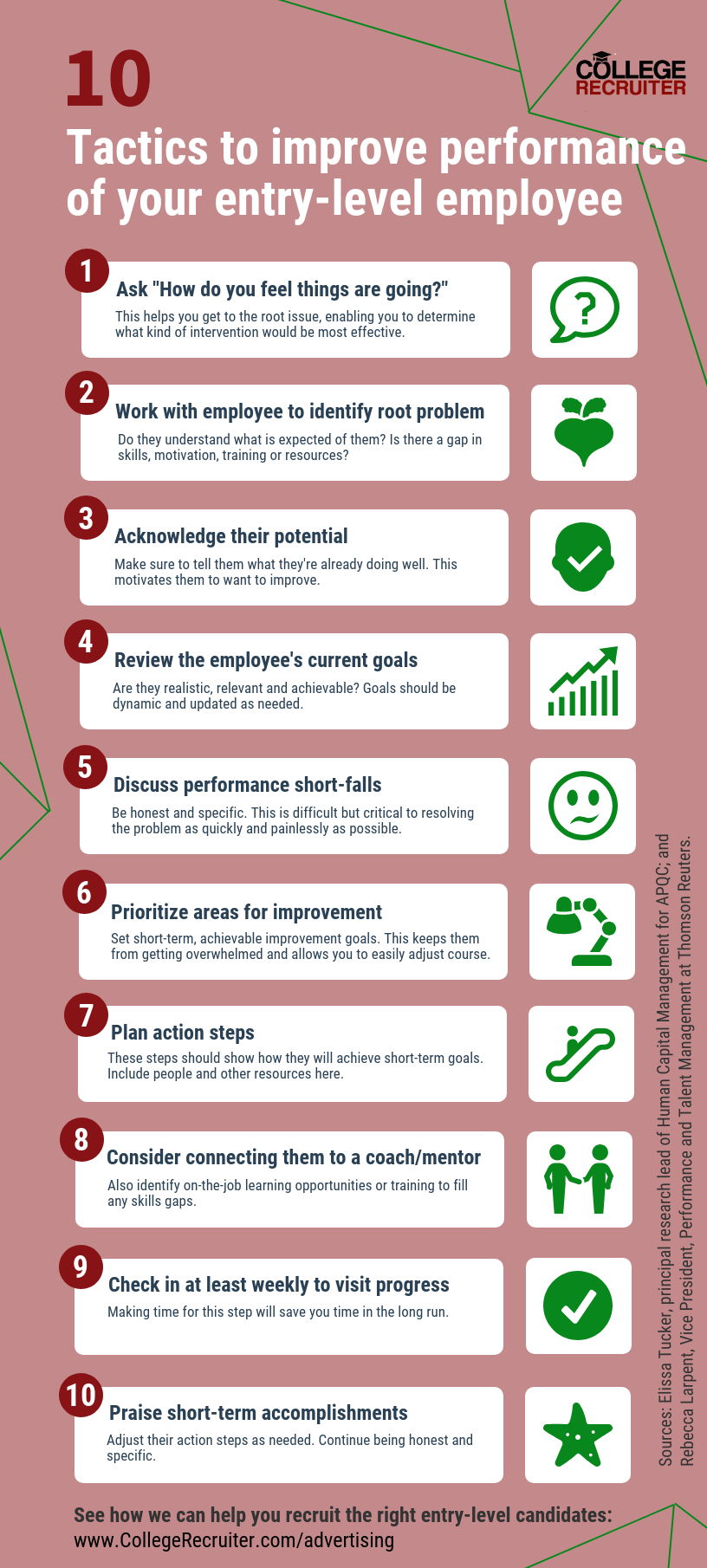Advice for Employers and Recruiters
10 ways employers can turn struggling new hires into rock star employees [infographic]
It’s a rewarding feeling for employers, HR professionals, and recruiters to attract that rock star entry-level employee. But it’s also as equally deflating when that recent college grad or other new hire isn’t working out. Many questions arise. Why isn’t this entry-level employee working out? What went wrong? There could be many reasons – a poor onboarding program, communication gaps, unidentified skills gaps, or a culture clash could be among the many potential reasons new employees struggle.
But before an employer considers terminating a struggling new hire – resulting in a costly hiring mistake – there are a number of steps that should take place, to help this entry-level employee improve, and eventually, make an impact.
Performance improvement strategies
Below are 6 things employers should consider when implementing performance improvement strategies for a struggling new hire, from Elissa Tucker, principal research lead of Human Capital Management for APQC, a non-profit benchmarking and best practices research firm, followed by 4 tips on how to handle performance feedback conversations, from Rebecca Larpent, Vice President, Performance and Talent Management at Thomson Reuters:
- Ask your entry-level hire how they feel things are going. This will help you get to the root cause of the performance problem and determine next steps and what kind of intervention would be most effective.
- Acknowledge what the new hire is doing well and the potential you see in him or her. The intent here is to motivate the employee to want to improve by sharing what you think they could bring to the organization as they grow into their role.
- Discuss performance short-falls. “Be honest and transparent about performance expectations that you would like to see the employee start to achieve,” says Tucker. “This is hard but critical for swiftly resolving the problem at hand.”
- Prioritize areas for improvement. Setting short-term, achievable improvement goals helps keep the employee motivated (as opposed to overwhelmed) and gives you the opportunity to course correct, without having wasted too much time, if the improvements aren’t happening as expected.
- Plan steps that will be taken to improve performance in the top priority area. Be sure to include a network of people and resources in this plan. “This relieves you of being the sole provider of development guidance and sets the employee up to solve their own performance issues in the future,” says Tucker.
- Check-in on at least a weekly basis to revisit how things are going and revise the plan as needed. Making time for this step in the short-term will save you time in the long run. It provides the opportunity to praise accomplishments, make plans for the next improvement priority, and have honest conversations regarding whether progress is going in the right direction for both the company and the employee.
When preparing for a performance feedback meeting or discussion with a struggling new hire, a “manager should come to the meeting prepared to share specific examples that demonstrate their concerns, including feedback from others who work closely with the employee,” says Larpent. “It is important they let the employee share their perspective as well.”
Communicate a plan to enhance performance
 In the meeting, managers should focus on these four additional areas to help communicate a plan to help enhance performance, says Larpent.
In the meeting, managers should focus on these four additional areas to help communicate a plan to help enhance performance, says Larpent.
- During the discussion, the manager and employee should work together to identify the root of the problem – does the employee understand what is expected of them? Is there a skill or capability gap? Do they have all the tools and information they need to succeed? An action plan should be put in place to address the issue(s).
- Together, they should review the employee’s current goals; are they realistic, relevant and achievable? Goals for the year should be dynamic and updated as needed.
- Consider connecting the employee with a coach or mentor within the organization to provide them with additional support. Regular 1-to-1s should be scheduled to ensure performance can be discussed on an ongoing basis.
- If the employee needs to work on a specific skill or capability, identify on-the-job learning opportunities or training within the company that would help fill any gaps.
Chances are, if a manager feels this entry-level employee is struggling or not meeting expectations, the employee likely also has concerns. But many recent college grads or new hires are often too timid to admit they need help. As an employer, manager, or HR professional, use these tips to address performance concerns, and help turn that new entry-level employee into the rock star employee you hoped you were hiring.
Keep informed of recruiting best practices by staying connected with College Recruiter on LinkedIn, Twitter, Facebook
